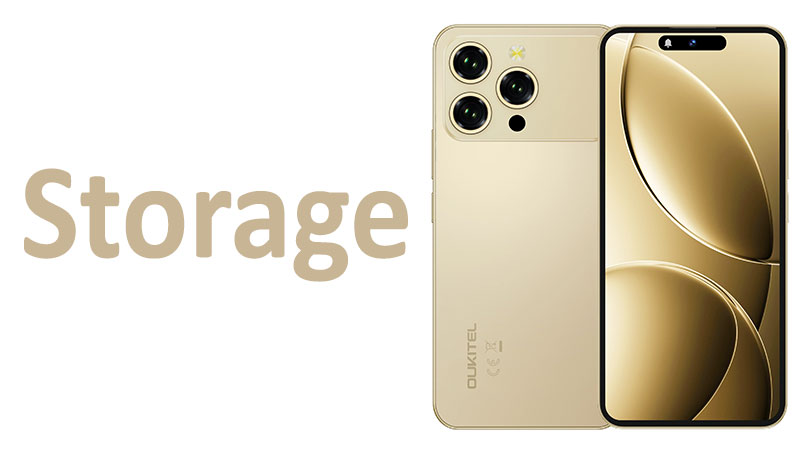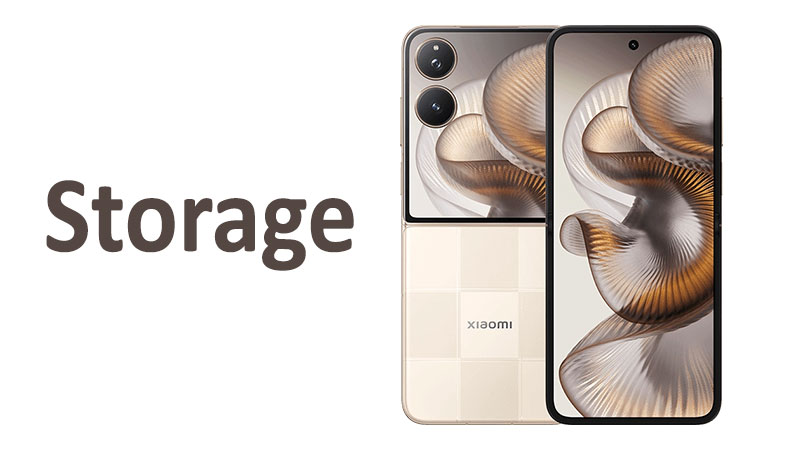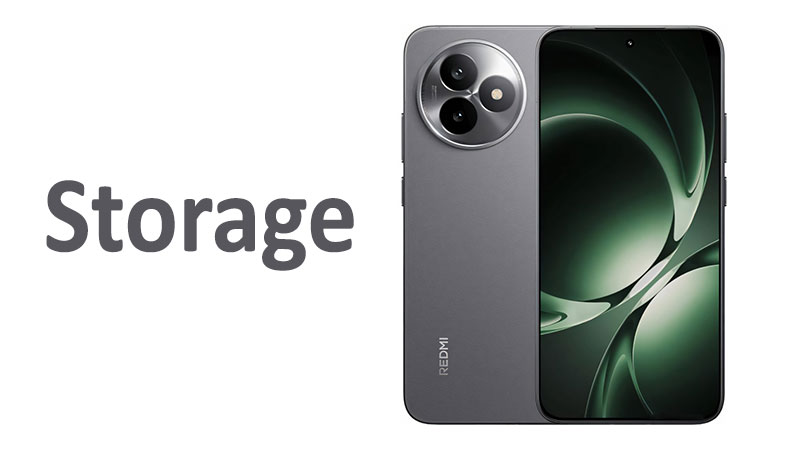Oukitel P1 Pro storage capacity and type are essential factors for potential owners. Understanding these technical details helps you pick the right model. This comprehensive guide explores the two available configurations thoroughly. We will examine the 256GB and 512GB internal storage options. We will also analyze the performance difference between 4GB and 8GB of RAM. The focus is on providing all the knowledge a buyer needs to make a final decision. We will discuss the expandable storage solution as well.
Dual Capacity Deep Dive: 256GB and 512GB Options
The Oukitel P1 Pro is designed to cater to varying user needs. It achieves this by offering two substantial internal storage options. Buyers can select either 256GB or 512GB capacity. This flexibility is a significant selling point for the device. Both options provide generous space for applications, media, and files. Choosing between them depends entirely on your daily usage habits.
The Baseline 256GB Configuration
The 256GB internal storage option serves as the entry point. It is paired with 4GB of RAM. This capacity is already double the industry standard of 128GB. This makes it a great choice for the average user. Most people will find 256GB more than sufficient for years. It handles extensive photo libraries and numerous applications.
Users can comfortably download music for offline listening. They can also keep several long-form videos stored locally. This option appeals to buyers who prioritize value. It offers high capacity without the premium price of the top-tier model. The 256GB version is ideal for general communication and content consumption. It provides a solid foundation for the Oukitel P1 Pro experience.
The High-End 512GB Option
The 512GB storage model is the flagship configuration. It comes paired with a high-performance 8GB of RAM. This enormous capacity is targeted at power users and creators. It offers peace of mind regarding space constraints. Running out of storage becomes an extremely rare event. Users can download entire seasons of TV shows. They can store massive amounts of high-resolution video footage.
This option is perfect for dedicated mobile gamers. Many high-quality games require several gigabytes of installation space. The 512GB variant allows users to install dozens of such titles simultaneously. It eliminates the constant need for file management. The Oukitel P1 Pro storage in this size is truly future-proof. It anticipates the ever-increasing file sizes of modern media and apps.
Usable Storage and System Consumption
The stated capacity is always the gross storage available. The operating system and pre-installed software consume a portion of this space. On the Oukitel P1 Pro, the Android OS typically uses 15GB to 20GB. This space is necessary for core system files and updates. This leaves the user with the net usable capacity.
For the 256GB model, expect around 235GB of free space immediately. The 512GB variant offers closer to 490GB for the user’s data. Buyers should always remember this distinction. Usable storage is the practical figure that matters for personal files. This is standard practice across all smartphone brands.
Performance Analysis: 4GB RAM vs. 8GB RAM
RAM is the phone’s short-term memory. It dictates multitasking ability and app launch speed. The Oukitel P1 Pro offers two distinct RAM configurations. It pairs 4GB RAM with 256GB storage. It includes a much more robust 8GB RAM with the 512GB storage. This is the biggest differentiator between the two models.
The 4GB RAM Experience: Limitations and Efficiency
The 4GB RAM configuration provides a functional, efficient experience. It is adequate for basic smartphone use. Users can browse the web and stream media smoothly. It handles communication apps like email and messaging without issue. This memory capacity is optimized for stability. It focuses on running one or two main apps reliably.
However, 4GB of RAM faces limitations during heavy multitasking. Switching between many demanding applications may cause slowdowns. The system aggressively closes background apps to free up memory. This means a slight delay occurs when re-opening a previously used app. This model is best for users who do not push their phone to its absolute limits.
The 8GB RAM Advantage: Multitasking and Gaming
The 8GB RAM model offers a significant performance boost. It fundamentally changes the multitasking experience. Users can keep many applications open in the background simultaneously. The phone rarely needs to close running programs. This results in instant switching between apps. This creates a much smoother, fluid user experience.
This larger memory pool is vital for mobile gaming. Games run more consistently with fewer frame rate drops. Editing high-resolution photos or videos also benefits greatly. The 8GB RAM is designed for power users and creators. It ensures the Oukitel P1 Pro can handle intensive, resource-heavy tasks easily. This configuration provides a noticeable increase in responsiveness and speed.
Specialized Comparison: P1 Pro RAM vs. Competitors
The P1 Pro’s dual-RAM strategy compares favorably to its direct competitors. Many budget phones stick strictly to 4GB or 6GB RAM. By offering an 8GB option, the P1 Pro competes with mid-range devices. For example, a rival phone might offer only 6GB at the P1 Pro’s top price point. The Oukitel P1 Pro storage and RAM combination offers superior value.
The 4GB model matches standard entry-level performance. It performs similarly to other phones in its immediate class. The 8GB model, however, delivers a flagship-level experience. This higher-tier option makes the Oukitel P1 Pro highly attractive. It allows buyers to choose a memory profile that truly fits their workflow.
Understanding Internal Storage Technology (Type)
The physical type of internal storage affects performance drastically. This is sometimes more important than the raw capacity itself. The Oukitel P1 Pro, being a value-oriented device, likely uses eMMC technology. eMMC stands for embedded MultiMediaCard. This technology is popular because it is cost-effective and dependable.
The Speed Factor: eMMC vs. UFS Standard
eMMC storage is generally slower than the newer Universal Flash Storage (UFS) standard. This difference is measurable in read and write speeds. UFS technology is designed to handle multiple tasks concurrently. It offers a much higher data transfer rate. High-end phones use UFS 3.1 or UFS 4.0.
eMMC typically handles operations sequentially. It cannot read and write data simultaneously with the same efficiency. This inherent architectural difference impacts the phone’s overall snappiness. The Oukitel P1 Pro storage is efficient for its technology type. However, buyers should not expect UFS-level speeds from this device.
Impact of Storage Speed on Daily Tasks
Slower storage speeds translate into longer waiting times for certain actions. Large application installations take more time to complete. The phone’s boot-up time may feel slightly extended. Saving large 4K video files after recording introduces a short delay. Copying large media folders from a computer takes longer than on premium devices.
The impact is often minimal for everyday light use. Regular tasks like checking social media remain fast and fluid. The internal storage is perfectly adequate for the phone’s intended use. The speed is consistent and reliable throughout the operating system. It remains a satisfactory experience for the average smartphone user.
Benchmarking Expectations for Budget Devices
It is crucial to set realistic expectations for the Oukitel P1 Pro. The device balances cost, capacity, and speed effectively. While the 256GB and 512GB capacities are large, the speed may be conservative. This is a common and necessary trade-off to keep the price low. Buyers should understand they are getting high capacity at budget speeds.
This configuration is ideal for maximizing storage space on a tight budget. If pure speed is your absolute priority, consider a more expensive phone. These devices often feature the faster UFS storage standard. The Oukitel P1 Pro storage prioritizes size and value over maximum performance speed. It delivers a great experience for the price.
Expandable Storage: The microSDXC Card Slot
The Oukitel P1 Pro offers the useful feature of expandable storage. It includes a microSDXC card slot for memory expansion. This means users can increase the total storage far beyond the internal 512GB limit. This is a huge benefit for media enthusiasts and content hoarders. It provides flexible and inexpensive capacity upgrades.
Hybrid Slot Design: The Dual-SIM Trade-Off
The card slot configuration involves an important compromise. The Oukitel P1 Pro uses a shared SIM slot, also known as a hybrid slot. This means the slot holds either a second SIM card or one microSDXC card. The user must decide which feature is more valuable to them. You cannot have both a second SIM card and expanded storage at the same time.
Users who need two separate phone numbers must forego the storage expansion. Those who need maximum media capacity must use only a single SIM. This is a crucial point for international travelers or business users. They often rely on both features. The hybrid slot is a common design decision to maintain a slim device profile.
Maximizing Expansion with High-Speed Cards
The speed of the external memory card matters immensely. A slow microSD card can quickly degrade the user experience. It can cause long delays when saving photos and videos. Media stored on the card may stutter during playback. Always purchase a high-speed memory card to avoid these issues.
Look for cards labeled as Class 10 and UHS Speed Class 3 (U3). A video speed rating of V30 or higher is best for recording video. These ratings guarantee fast, reliable data transfer rates. Investing in a quality card ensures smooth performance. It maximizes the utility of the Oukitel P1 Pro storage expansion feature.
Best Practices for File Management
Effective file management is key when using expandable storage. Always install applications directly onto the internal 256GB or 512GB storage. This internal memory is always faster and more reliable for apps. Reserve the microSDXC card exclusively for media and documents. Store photos, music, movies, and large document files there.
This strategy ensures that applications launch quickly and run smoothly. It prevents the slower microSD card from hindering system performance. Furthermore, the external card serves as a convenient backup for media. Users can easily remove it to transfer files to other devices. This thoughtful approach optimizes the entire storage system.
Pros, Cons, and Critical Buyer Considerations
The Oukitel P1 Pro’s storage strategy is a major selling point. It combines high capacity with flexible memory options. However, every device involves a series of trade-offs. Buyers must weigh these carefully before purchasing the phone.
Advantages of the P1 Pro’s Storage Range
The availability of two large internal storage options is a huge plus. The 512GB model provides exceptional space for demanding users. The 8GB RAM paired with the 512GB storage offers smooth performance. This ensures excellent multitasking capabilities. The included microSDXC slot provides inexpensive, nearly unlimited expansion. This feature extends the useful life of the device significantly. The storage options cater to both moderate and power users effectively.
Key Disadvantages and Design Compromises
The primary drawback is the probable use of slower eMMC storage technology. This affects overall system snappiness compared to higher-end UFS devices. The 4GB RAM in the base model is minimal for today’s heavy apps. It requires careful memory management from the user. The shared SIM and microSDXC slot forces a difficult choice. Users must sacrifice dual-SIM functionality for maximum storage.
Essential Advice for Potential Buyers
Buyers must first determine their required capacity. The 256GB model is sufficient for the majority of users. Only choose the 512GB if you are a heavy gamer or media creator. Secondly, consider the RAM difference carefully. The 8GB RAM dramatically improves the multitasking experience. If you use many apps daily, the 8GB version is worth the upgrade.
Finally, anticipate the shared slot limitation. Decide if a second SIM card is more important than massive storage expansion. This choice defines how you will use the Oukitel P1 Pro storage long-term. Always buy the best-rated microSD card you can afford for the best results.
The Ultimate Oukitel P1 Pro Storage Buyer’s Guide
Choosing the correct Oukitel P1 Pro model is an investment decision. The phone offers two clearly defined user profiles through its configurations. Matching the right version to your specific needs is the key to satisfaction. This final guide helps solidify that decision.
Matching Configuration to Your User Profile
The 256GB storage and 4GB RAM configuration suits the light to moderate user. This user browses the web, uses social media, and takes average photos. They stream most of their media and play only casual games. This version offers great value and reliable performance for these activities. It is the cost-effective choice for daily communication.
The 512GB storage and 8GB RAM model is for the power user and content creator. This user runs intensive applications, plays graphically demanding games, and records lots of video. They value instant responsiveness and the ability to keep many apps open. The extra RAM and capacity justify the higher price tag for this group. This is the best choice for speed and performance longevity.
Managing Limited RAM and Storage Speed
Users of the 4GB RAM model should be proactive about app management. Routinely close applications that are no longer needed. This frees up precious memory for the currently running app. Utilize the cloud for long-term storage of older files and photos. This keeps the internal storage clean and fast for active use. These habits minimize any performance lag caused by the smaller RAM pool.
Both models benefit from using the internal memory for critical files. Only move large media libraries to the external microSD card. This ensures that the operating system and key applications always run at optimal speed. The Oukitel P1 Pro storage system performs best when managed intelligently.
Long-Term Value and Future-Proofing
Both storage configurations offer excellent long-term value. The 256GB model provides more capacity than many competitors at a similar price. It ensures the phone will remain usable for several years. The 512GB version is highly future-proof. It anticipates the increasing storage demands of the next generation of mobile apps.
The expandable storage feature significantly extends the device’s lifespan. Users can continue to add capacity as their media libraries grow. The Oukitel P1 Pro storage system is designed for endurance. It offers a smart balance of internal capacity and flexible expansion. This makes it a reliable choice for the foreseeable future.
Conclusion
The Oukitel P1 Pro storage options deliver a compelling package for value-seeking buyers. The availability of 256GB and 512GB internal storage is impressive for its segment. The configurations wisely pair higher storage with better RAM. This gives buyers a clear performance choice. The 512GB with 8GB RAM provides a true performance upgrade. The 256GB with 4GB RAM is a strong, economical baseline.
The shared microSDXC slot is the primary compromise users must accept. They must decide between using two SIM cards or expanding their memory. Despite the likely eMMC technology, the performance is stable and reliable. The P1 Pro is an excellent choice for users who prioritize large, affordable storage. Its two configurations allow for a tailored purchase decision. This flexibility makes the Oukitel P1 Pro highly competitive in the budget to mid-range market.
Frequently Asked Questions (FAQ)
What are the two storage configurations available for the Oukitel P1 Pro?
The Oukitel P1 Pro comes in a 256GB internal storage model with 4GB RAM. It also offers a higher-end 512GB internal storage model with 8GB RAM.
Is the 4GB RAM model suitable for mobile gaming?
The 4GB RAM model can handle casual mobile games. It may struggle with the latest, most graphically intensive games, causing occasional slowdowns.
Can I use two SIM cards and a memory card simultaneously in the P1 Pro?
No. The Oukitel P1 Pro has a shared, or hybrid, SIM slot. You must choose between using a second SIM card or a microSDXC card.
Is the 512GB storage option noticeably faster than the 256GB option?
The storage speed is likely similar in both versions due to the underlying technology. However, the 8GB RAM in the 512GB model makes the overall experience much faster.
Should I pay extra for the 8GB RAM configuration?
Yes, if you frequently switch between many apps, use editing software, or play demanding games. The 8GB RAM significantly enhances multitasking fluency.



